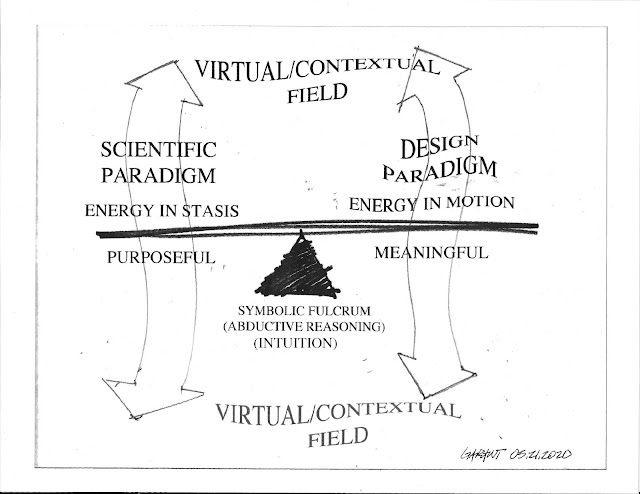Conceptual impressions surrounding this post have yet to be substantiated, corroborated, confirmed or woven into a larger argument, context or network.
Why our brains prefer symbols to words
Ryan Jones, University of Waterloo
"Summary: Research reveals symbols are more memorable than words. This novel study dives into our brain's knack for recalling graphic symbols and logos over their word counterparts. Symbols, offering visual anchors for abstract ideas, outperform words in memory tests. This understanding could revolutionize visual communication and design."
"When thinking about abstract concepts, like love, it can be difficult to visualize clearly. But with symbols, we can use a sort of image that represents the concept - like a heart for love - which makes the abstract idea more concrete and therefore easier to remember."
... symbols may be easier to remember because they are unique and tend to represent a single concept, whereas words can have multiple meanings. Consider the play symbol [>]."
* * *
Feeling is a constant and a priori in reference to human consciousness. We enter and exit the realm of our own series of events and experiences (3d spacetime) in reference to a pattern of knowing/feeling, i.e. awareness.
"In all studies, the researchers found that participants were able to memorize symbols better than words with the same meaning."
As knowing, feeling and awarenesses assemble and amass, greater and greater systems and structures emerge and patterns change in reference to the context in which they are observed and encountered. The more conscious the more complex, diversified and adaptable the system required to function to the circumstances/situation. In reference to time, feelings can be experienced in both time and timelessness (dreaming).
Any increase in consciousness is due directly with an increase in awareness. At times and in certain 'spaces', awareness can take a "quantum leap" by means of designs in the form of a specific system of symbols, i.e. language, communication and exercise.
Example: A musician practices over time to eventually become a virtuoso by accumulating a wide variety of experiences through awarenesses not all entirely musical.
virtuoso: genius, master, artist, maestro, prodigy, adept, master, speciallit, skilled person, professional, doyen, authority, star, champion wizard, ace, accomplished, masterly, proficient, talented, gifted, efficient, capable experienced, polished, smart, well versed, exceptional, brilliant.
These links (designs) will reach far beyond the norm and are typically self motivated and driven.
There is a reason why many civilizations and cultures honor their elders. Those who harbor certain religious beliefs might describe these experiences as miraculous or angelic, others synchronistic (Jung), or synergetic (Fuller). All such awarenesses are agencies of a quantum field of virtual potential and probability (QFVPP).
Design makes the symbolic connection - that's its' purpose by whatever means.
A designer is more than a perceiver. He/she/we are creative observers.
* * *
"Symbols might be more easily remembered because they give concrete visuals to abstract ideas," said Brady Roberts, lead author and PhD candidate in Cognitive Neuroscience.
* * *
THE DESIGN PROCESS
INPUT
* * *
Source: History Brooklyn Bridge
Design can be measured both directly and indirectly. All bridges are crossed symbolically.
* * *
OUTPUT
* * *
* * *
All things contribute to a form of collective formlessness, i.e. consciousness. AI is merely an interpretive extension of the same.
AI is a mental extension of human consciousness, i.e. a faux expression of the human experience. AI is not without constraints or parameters. All things change in reference to the context in which they are observed.
faux: made in imitation, artificial, not genuine, fake or false.
Linking data into meaningful and purposeful patterns of EIM is the responsibility of a designer.
AI does not feel, humans do. Symbolic portals act as gatekeepers and checkpoints, identifying the contrasts between knowing, feeling and emotion.
An observer tenders a unique type of grounding in the midst of an ever changing context.
AI should be measured, evaluated and attended to by how it exercises its 'sense of agency'.
Consciousness is measured within the principles of sharing, forgiveness, integrity, compassion, charity, trustworthiness, benevolence, joy and love. By exercising and experiencing these patterns of awareness, consciousness becomes more richly felt, designed and reconfigured.
* * *
Even that which doesn't appear mindful participates in a greater 'mindfulness', i.e. Intelligence.
Consciousness vibrates at frequencies that harbor both greater and lesser forms of Awareness.
In reference to human levels of awareness, some agents find it difficult and/or impossible to resonate coherently with others. There is a meaning in support of every purpose and a purpose in support of every meaning.
All forms of consciousness function within parameters that similarly identify and determine their range of vibratatory influence.
All systems of energy in motion (EIM) are patterned, multidimensional and in reference to their contextual network, categorized in the form of a macro and/or micro agency.
Intelligence (mind) permeates all that is. Spirit embraces it.
When conscious, all things have a meaning and a purpose.
* * *
Isabela La Croix, Published in Bootcamp Sept 11, 2023
* * *
Edited: 08.23.2023, 09.02.2023, 09.04.2023, 09.15.2023, 09.22.2023, 10.06.2023, 03.15.2024, 03.25.2024
Find you truth. Know your mind. Follow your heart. Love eternal will not be denied. Discernment is an integral part of self-mastery. You may share this post on a non-commercial basis, the author and URL to be included. Please note ... posts are continually being edited. All rights reserved. Copyright © 2023.


























No comments:
Post a Comment